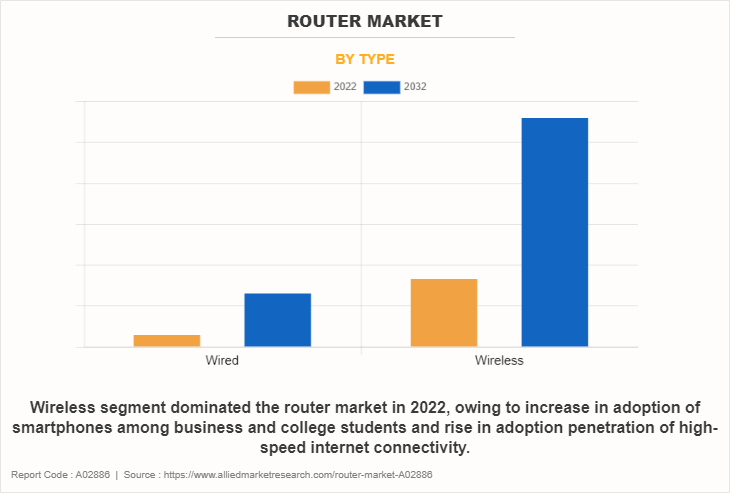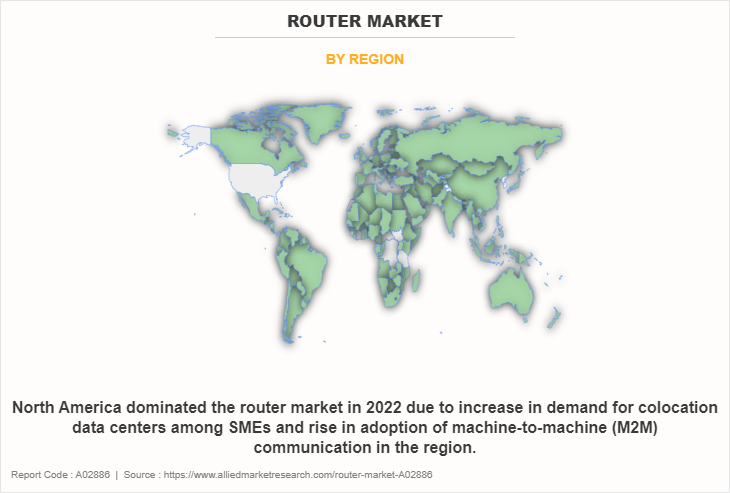Router Market Statistics: 2032
The global router market size was valued at $19.6 billion in 2022, and is projected to reach $44.4 billion by 2032, growing at a CAGR of 8.8% from 2023 to 2032.
Increase in demand for faster internet connectivity technology among consumers and rise in adoption of connected device among the healthcare, education and BFSI industry are some of the important factors that boost the global router market across the globe. In addition, rise in penetration of the bring-your-own-device policy among the small & medium-sized enterprises (SMEs) positively impacts the growth of the market. However, factors such as high implementation cost of wireless router solutions and overheating and overloading of router technology are expected to hamper the market growth. On the contrary, an increase in government initiatives for smart city projects is expected to offer remunerative opportunities for the expansion of the router industry during the forecast period.

A router is a network connected device that connects two or more packet-switched networks to transfer data between computer systems. It is used to manage data traffic between computer networks by means of sending data packets to their anticipated IP addresses and permitting multiple devices to use the same internet connection. In addition, routers are developed for facilitating organization to transfer data between local area networks (LANs) and wide area networks (WAN) in specific regions. Furthermore, router is the robust way to use and prioritize a large collection of security data by keeping immediate information to the organizations.
Segment Review
The global router market is segmented on the basis of type, end user, and region. By type, the market is bifurcated into wired and wireless. By end user, it is categorized as BFSI, IT & telecom, education, healthcare, and others. As per region, the market is analyzed across North America, Europe, Asia-Pacific, and LAMEA.

Depending on type segment, the wireless segment dominated the router market share in 2022 and is expected to continue this trend during the forecast period, owing to the increased usage of wireless router in small businesses and residential applications, rise in internet penetration, and surge in consumer demand for better networking infrastructure. However, the wireless segment is also expected to witness the highest growth in the upcoming years, owing to increase in utilization of smart devices, such as smartphones and tablets, along with rise in the availability of affordable wireless routing services.

Region-wise, the router market was dominated by North America in 2022 and is expected to retain its position during the forecast period, owing to increase in demand for colocation data centers among SMEs and growth in adoption of machine-to-machine (M2M) communication, further contributing to the market growth within the region. However, Asia-Pacific is expected to witness significant growth during the forecast period, owing to the surge in government projects for smart city development, coupled with surge in need to monitor network violations and offences in this region.
Top Impacting Factors
Increase in demand for faster internet connectivity technology among consumers
The rise in demand for faster internet connectivity and the increase in the number of internet-connected devices are directly influencing the growth of the global router market. The high-speed internet connectivity technology allows users several benefits that include immediately collecting operational data from remote equipment and streamlining the online banking service, which drives the growth of the market across the globe. In addition, internet connectivity technology provides numerous applications to business, which includes transferring and cross-referencing data, collecting employee performance information, and delivering marketing products effectively.
Furthermore, the popularity of routers lies in the fact that the entire world is turning toward digitalization, as well as government authorities and companies are investing substantial amounts of funds in transmission and networking services. For instance, in August 2022, DriveNets, a leader in cloud-native networking solutions, secured an investment of $262 million in a Series C venture capital funding round, as the demand booms for its cloud-based alternative to network routers. This latest round of funding is expected to develop future technology solutions, track new business opportunities, and enlarge the company’s global operations and support teams to meet the growing customer demand. Hence, such strategic investments are progressively boosting the implementation of routers, as it has the potential to manage data traffic and allow multiple devices to use the same Internet connection.
Moreover, Internet of Things (IoT) technology is progressively used in connected devices across a range of industries, such as aviation, manufacturing, agriculture, healthcare, logistics, and many other industries, which helps them to collect and organize data from different data streams and organize it efficiently.
In addition, it helps companies gain much superior insights into their business operations and their customer’s services or products. All these factors are encouraging businesses to use connectivity technology, which in turn, reinforces the router market growth.
Rise in the adoption of connected devices in the healthcare, education, and BFSI industry
The increasing adoption of connected healthcare devices, such as heart rate monitoring equipment and remote patient monitoring apparatus among healthcare professionals is propelling the growth of the market across the globe. In addition, the connected medical device helps healthcare professionals focus on active patient engagement and provide patient-centric care delivery service. Thus, this service requires high-speed internet connectivity technology among the patients and doctors, which drives the growth of the market. Moreover, the connected devices also find suitable applications in telehealth and telemedicine to collect vitals, monitor progress, view ultrasounds, hear heart and lung sounds, and capture images of skin, ears, eyes, and other areas.
According to Netscribes, around 88% of the healthcare institutions in the U.S. are investing in remote patient monitoring (RPM) solutions. Also, about 68% of healthcare institutions prefer patient monitoring solutions, as these solutions help to improve patient outcomes, provide personalized care, patients care about their health, and enhance compliance rates. These aforementioned benefits concerning connected medical devices are propelling the adoption of routers to manage data traffic, which in turn, drives the market growth.
Moreover, digital technology helps the education system to achieve several objectives such as delivering effective education service, increasing collaboration between students and teachers, and improving student performance, which further enhances the growth of the router market.
Most students across the U.S. and Canada have been adopting smartphones and other connected devices to improve their knowledge, learn new skills & technology, and immediately connect with their parents during emergencies, which accelerates the market growth. Thus, an increase in the use of connected devices in the healthcare, education, and BFSI industries to meet customer expectations is an important factor in boosting the global router market.
Restraints
High implementation cost of wired router solutions
Router provides high-speed internet data at a low cost due to its low operating cost. However, the high cost of deployment and implementation of wired router solutions is due to the involvement of additional hardware expenses and a lack of potential infrastructure upgrades, which are the key reasons for halting the growth of the router market. Furthermore, wired routers are typically more expensive than wireless router solutions, as it has more ability to handle the higher data rates of wired connections, which is also restraining the market growth.
Moreover, the number of countries concerned with wired solutions, local authority, and regulatory policies have reduced the problems in the development of wired routers by imposing excessive administrative and financial obligations on operators, thus blocking investment. The prolonged purchase process, lengthy permitting process, high fees, and outdated rules, which restrict access, are the key factors that limit router deployment. Moreover, auxiliary equipment such as tower erection devices, antennas, power batteries, and distribution units are expensive for wired routers. As a result, these aforementioned restraints are expected to slow down the growth of the router market during the forecast period.
Opportunities
Government initiatives for smart city projects
The increase in penetration of smart cities across developing nations, such as China, Japan, and India, to deliver core infrastructure, clean and sustainable environment, and give a decent quality of life to their citizens is expected to provide lucrative opportunities to boost the router market trends during the upcoming years. In addition, an increase in investment by the government into the smart city project to streamline IoT and digital network connectivity devices, enabling real-time data processing and analytics.
For instance, in June 2021, India expanded its smart city projects and new-age practices to 4,000 cities with a population of 500,000. The smart cities' mission is to promote economic growth and enhance people's quality of life by facilitating local area development and utilizing technology. Such strategic initiatives are providing novel opportunities to boost the router industry growth during the forecast period.
Moreover, the router technology also finds broader applications in smart city projects, allowing numerous regional governments to help with the collection, sharing, and analysis of data from sources, such as IoT with easy network connectivity and management, and sensor machines. Besides, router technology provides a set of reliable and powerful wireless devices to meet the demands of the current parking infrastructure solution in smart cities.
These aforementioned factors are expected to drive the demand for routers in smart city applications, which in turn, drives the market growth. In addition, wireless router technology offers several advantages to smart city projects, which include improving service efficiency, enhancing safety as well as security of people, and attracting businesses and startups with fast internet connectivity. These factors are impacting the government to make investments in router solutions, which is providing lucrative opportunities for the market.
Key Benefits for Stakeholders
- The study provides an in-depth analysis of the global router market forecast along with current & future trends to explain the imminent investment pockets.
- Information about key drivers, restraints, & opportunities and their impact analysis on global router market trend is provided in the report.
- The Porter’s five forces analysis illustrates the potency of the buyers and suppliers operating in the industry.
- The router market analysis from 2022 to 2031 is provided to determine the market potential.
Router Market Report Highlights
| Aspects | Details |
| Market Size By 2032 | USD 44.4 billion |
| Growth Rate | CAGR of 8.8% |
| Forecast period | 2022 - 2032 |
| Report Pages | 292 |
| By Type |
|
| By End User |
|
| By Region |
|
| Key Market Players | AsusTek Computer Inc., D-Link Corporation, TP-Link Corporation Limited, Xiaomi, EERO LLC, NETGEAR, Cisco Systems, Inc., Synology Inc., Belkin, Huawei Technologies Co. Ltd. |
Analyst Review
The global router market is witnessing decent growth, due to the increasing number of router technology providers and the favorable government policies & mandates for improving networking infrastructure.
In accordance with several interviews conducted of the top level CXOs, the adoption of routers has increased in last few years, due to the growing manufacturing processes that help organizations to monitor production level, and to deliver improved customer services. In addition, routers technology is being used across a number of fields to help drive productivity, improve efficiency and save time and organizational funds. Furthermore, surge in adoption of cloud as well as mobile applications is expected to drive the growth of the market.
Industry experts stated that the router market is anticipated to witness a considerable growth, owing to the digital transformation initiatives in industries and rapid adoption of IoT among various industrial sectors. Further, increase in mobile and internet penetration, hyperconnectivity, and various other related trends are creating a significant deployment of router service.
Moreover, key players in the router market such as Cisco, Huawei, TP Link, and Netgear, account for a significant share of the market, followed by some other top vendors in the local and regional markets. With larger requirements for routing services, companies introduced various strategies to strengthen their market position capabilities. For instance, in November 2022, TP-Link, a global leader of consumer and business networking products, introduced new Wi-Fi 7 routers for home and business applications. Such strategic initiatives by the market players are expected to contribute to significant growth of the router market across the globe.
Additionally, market players have expanded their business operations and geographical footprint by making strategic collaboration and partnerships. For instance, in October 2022, Invendis, a global provider of IoT platforms and cloud computing solutions, and chip maker MediaTek, proclaimed a strategic collaboration to roll out 5G and Wi-Fi router solutions. The collaboration is expected to enable an inclusive portfolio of solutions and considerable manufacturing capabilities in India. Such factors and strategic advancements propel the growth of the router market.
The router market was valued at $19,586.63 million in 2022.
Increase in demand for faster internet connectivity technology among consumers and rise in adoption of connected device among the healthcare, education and BFSI industry are some of the important factors that boost the global router market across the globe.
North America is the largest regional market for Router.
The key players profiled in the router market analysis are Asustek Computer Inc., Belkin International Inc., Cisco systems Inc., D-Link Corporation, Eero LLC, Huawei Technologies Co., Ltd., Netgear, Synology Inc., TP link Technologies Co. Ltd., and Xiaomi.
The key growth strategies for Router Market include product portfolio expansion, acquisition, partnership, merger, and collaboration.
Loading Table Of Content...
Loading Research Methodology...


